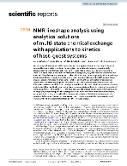NMR lineshape analysis using analytical solutions of multi-state chemical exchange with applications to kinetics of host-guest systems

Author
Velychkivska, Nadiia
Hill, Jonathan P
Labuta, Jan
Publication date
2022Published in
Scientific ReportsVolume / Issue
12 (1)ISBN / ISSN
ISSN: 2045-2322Metadata
Show full item recordCollections
This publication has a published version with DOI 10.1038/s41598-022-20136-4
Abstract
Nuclear magnetic resonance (NMR) lineshape analysis is a powerful tool for the study of chemical kinetics. Here we provide techniques for analysis of the relationship between experimentally observed spin kinetics (transitions between different environments A, B, ...) and corresponding chemical kinetics (transitions between distinct chemical species; e.g., free host and complexed host molecule). The advantages of using analytical solutions for two-, three- or generally N-state exchange lineshapes (without J-coupling) over the widely used numerical calculation for NMR spectral fitting are presented. Several aspects of exchange kinetics including the generalization of coalescence conditions in two-state exchange, the possibility of multiple processes between two states, and differences between equilibrium and steady-state modes are discussed. 'Reduced equivalent schemes' are introduced for spin kinetics containing fast-exchanging states, effectively reducing the number of exchanging states. The theoretical results have been used to analyze a host-guest system containing an oxoporphyrinogen complexed with camphorsulfonic acid and several other literature examples, including isomerization, protein kinetics, or enzymatic reactions. The theoretical treatment and experimental examples present an expansion of the systematic approach to rigorous analyses of systems with rich chemical kinetics through NMR lineshape analysis.
Keywords
dynamic nmr, ligand interactions, binding, enantiomerization, isomerization, mechanism, domain
Permanent link
https://hdl.handle.net/20.500.14178/2909License
Full text of this result is licensed under: Creative Commons Uveďte původ 4.0 International







